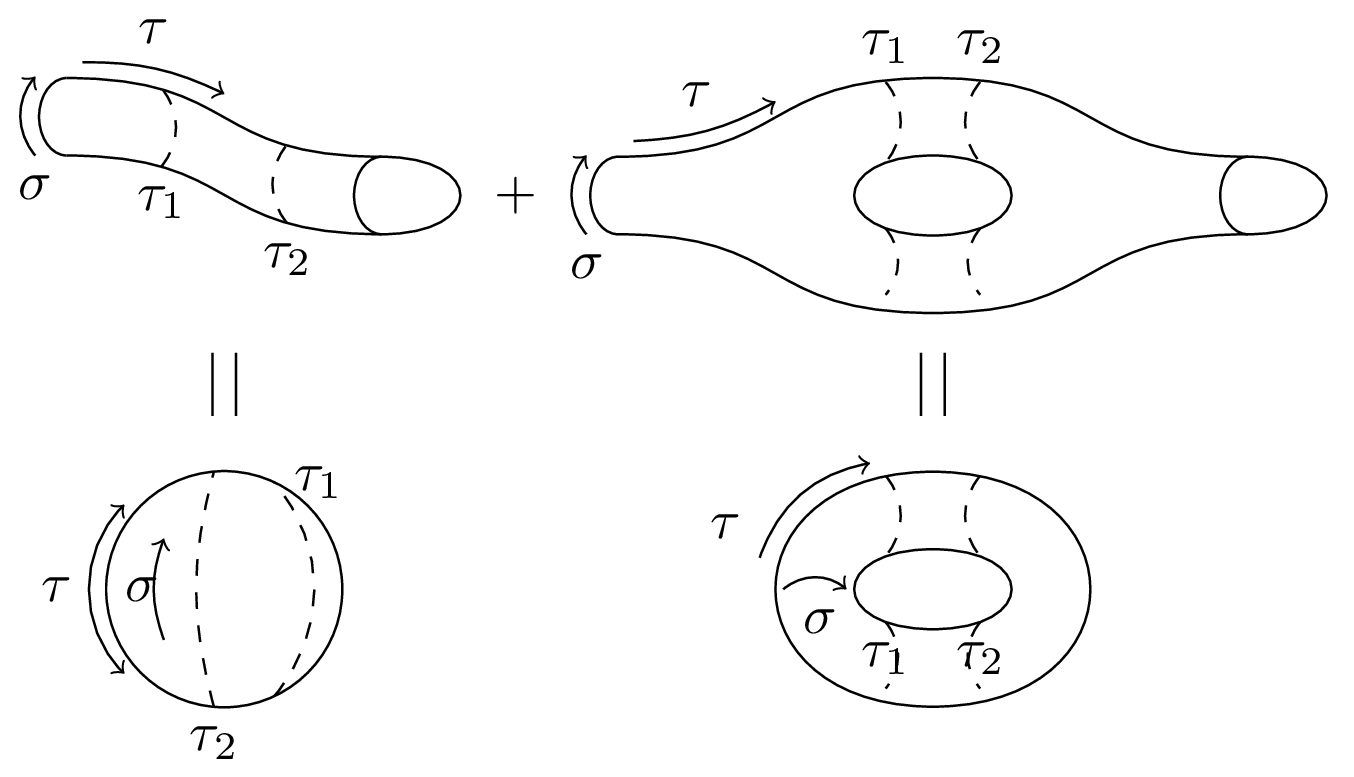Closed String Topologies
Tags
When calculating scattering amplitudes via the path integral, we must sum over all possible world-sheet topologies. To characterize the types of world-sheets that have to be considered at each level of its perturbative expansion, string theory makes use of the following theorem:
Every compact, connected, oriented two-dimensional manifold is topologically equivalent to a sphere with $g$ handles ($g$ for genus) and $b$ boundaries. A topological invariant of two-dimensional oriented surfaces is the Euler characteristic $\chi = 2 - 2g - b$.
What this boils down to is that we can obtain the topological characteristics of higher and higher loop-level world-sheet topologies by successively increasing in one-step increments the number of handles $g$ in case of the closed string and the number of boundaries $b$ for the open sector. This gives the topologies in this figure for the vacuum diagram of the closed sector up to one-loop level. For the open sector, see open string topologies.

Edit
Download
Code
closed-string-topologies.tex (114 lines)
\documentclass[tikz]{standalone}
\usetikzlibrary{tqft,calc}
\begin{document}
\begin{tikzpicture}[
every tqft/.append style={
transform shape, rotate=90, tqft/circle x radius=7pt,
tqft/boundary separation=1cm, tqft/view from=incoming
}
]
% cobordism at upper left
\pic[
tqft/cylinder to prior,
name=a,
every incoming lower boundary component/.style={draw},
every outgoing lower boundary component/.style={draw},
cobordism edge/.style={draw},
];
\pic[
tqft/cup,
cobordism edge/.style={draw},
at=(a-outgoing boundary),
];
% annotation of cobordism at upper left
\coordinate (temp1) at ($(a-incoming boundary.west)!0.3!(a-outgoing boundary.west) +(0,0.08)$);
\coordinate (temp2) at ($(a-incoming boundary.west)!0.7!(a-outgoing boundary.west) +(0,-0.08)$);
\draw[dashed]
(temp1) node[below] {$\tau_1$} to[bend right=40] ++(0,0.5)
(temp2) node[below] {$\tau_2$} to[bend left=40] ++(0,0.5);
\draw[->] ($(a-incoming boundary.west) - (0.2,0)$) node[below] {$\sigma$} to[bend left=40] ++(0,0.5);
\draw (a-outgoing boundary) ++(0.85,0) node {$+$};
\draw[->] ($(a-incoming boundary.east)+(0.1,0.1)$) to[bend left=13] +(0.9,-0.2);
\node[above] at ($(a-incoming boundary.east)+(0.55,0.1)$) {$\tau$};
% cobordism at upper right consisting of two 'pants' and a cup
\pic[
tqft/pair of pants,
name=b,
every incoming lower boundary component/.style={draw},
cobordism edge/.style={draw},
at={($(a-outgoing boundary)+(1.5,0)$)},
];
\pic[
tqft/reverse pair of pants,
name=c,
every outgoing lower boundary component/.style={draw},
cobordism edge/.style={draw},
at=(b-outgoing boundary 1),
];
\pic[
tqft/cup,
cobordism edge/.style={draw},
at=(c-outgoing boundary),
];
% annotation of cobordism at upper right
\draw[->] ($(b-incoming boundary.west) - (0.2,0)$) node[below] {$\sigma$} to[bend left=40] ++(0,0.5);
\coordinate (temp1) at ($(b-between outgoing 1 and 2)!0.2!(c-between incoming 1 and 2) +(0,0.72)$);
\coordinate (temp2) at ($(b-between outgoing 1 and 2)!0.8!(c-between incoming 1 and 2) +(0,0.72)$);
\draw[dashed]
(temp1) node[above] {$\tau_1$} to[bend left=40] +(0,-0.51) ++(0,-0.93) to[bend left=40] ++(0,-0.42)
(temp2) node[above] {$\tau_2$} to[bend right=40] +(0,-0.51) ++(0,-0.93) to[bend right=40] ++(0,-0.42);
\draw[->] ($(b-incoming boundary.east)+(0.1,0.1)$) to[bend right=13] +(0.9,0.25);
\node[above] at ($(b-incoming boundary.east)+(0.5,0.2)$) {$\tau$};
% drawing ring
\pic[
tqft ,
name=d,
incoming boundary components=0,
outgoing boundary components=2,
cobordism edge/.style={draw},
anchor=between outgoing 1 and 2,
at={($(b-between outgoing 1 and 2)!0!(c-between incoming 1 and 2) - (0,2.5)$)},
];
\pic[
tqft ,
name=e,
incoming boundary components=2,
outgoing boundary components=0,
cobordism edge/.style={draw},
at = {(d-outgoing boundary 1)},
];
\coordinate (temp1) at ($(d-between outgoing 1 and 2)!0.2!(e-between incoming 1 and 2) +(0,0.72)$);
\coordinate (temp2) at ($(d-between outgoing 1 and 2)!0.8!(e-between incoming 1 and 2) +(0,0.72)$);
\draw[dashed]
(temp1) to[bend left=40] +(0,-0.51) ++(0,-0.93) node[below] {$\tau_1$} to[bend left=40] ++(0,-0.42)
(temp2) to[bend right=40] +(0,-0.51) ++(0,-0.93) node[below] {$\tau_2$} to[bend right=40] ++(0,-0.42);
\coordinate (temp1) at ($(d-between outgoing 1 and 2)!0.5!(e-between incoming 1 and 2)$);
\coordinate (temp2) at (a-between first incoming and first outgoing);
\draw[->] ($(e-incoming boundary 2)+(-1.1,-0.3)$) node[above left] {$\tau$} to[bend left=30] +(0.7,0.6);
\draw [->] ($(d-between outgoing 1 and 2) + (-0.45,0)$) node [below right] {$\sigma$} to[bend left=40] +(0.4,0);
\draw (temp1) ++(-0.075,1.5) -- ++(0,-0.4) ++(0.15,0) -- +(0,0.4);
% drawing and annotating ball
\node[draw, shape=circle, minimum width=1.5cm]
at (temp1-|temp2) (circ) {};
\draw[dashed] (circ) +(265:0.75) node[below] {$\tau_2$} to[bend left=15] +(95:0.75);
\draw[dashed] (circ) +(295:0.75) to[bend right=40] +(65:0.75) node[right] {$\tau_1$};
\draw[->] (circ) +(220:0.5) to[bend left=20] +(140:0.5);
\node[right] at(circ.west) {$\sigma$};
\draw (circ) ++(-0.075,1.5) -- ++(0,-0.4) ++(0.15,0) -- +(0,0.4);
\draw[<->] (circ.south west) +(-0.1,0) to[bend left=45] ($(circ.north west)+(-0.1,0)$);
\node[left=0.25em] at(circ.west) {$\tau$};
\end{tikzpicture}
\end{document}